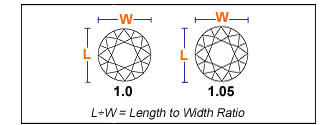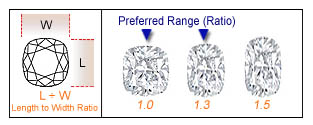Your Online Source for Wholesale Diamonds



Shape
The external surface or outline figure of a specific diamond is called the shape of that diamond. Following are the shapes or figures of diamonds: Round, Princess, Asscher, Emerald, Cushion, Radiant, Heart, Marquise, Pear, Oval and Triangle.
Ratio
The proportional relation between length and width of a diamond is called the ratio of that diamond.
Example: Princess cut Diamond
Measurement: 6.25 - 6.05 x 3.77 mm
Measurement: Length - Width x Depth
Length-to-width ratio: Length / Width
= 6.25 / 6.05
= 1.03 (This will look perfectly square to the eye)
Following ratio shows the most appealing for that shape however, personal preference prevails, and some may prefer a shorter, wider outline; or longer, thinner shape.
ROUND CUT Diamond is the most preferred diamond shape as it is most classic and most sparkly shape. The round-brilliant cut is the most visually brilliant because of its 360-degree symmetrical shape and has the most facet count (57 facets: 58 with a culet) than other shapes, therefore it reflects most of the lights that goes in from more angles. Round-brilliant diamonds are the only shape to have this ideal proportion defined. Stone in this highest cut grade exhibit a perfect "Hearts & Arrows" pattern. With other diamond shapes, having lower color grade and clarity usually means giving up some of the beauty of the stone. Because a round-cut diamond gives out higher levels of brilliance and fire, it will offer much of the same pleasant appeal even if it has a lower color, clarity, or cut.
Length-to-width ratio of Round cut Diamond determines how a diamond will look like when viewed from above. For round shaped diamond, look for a length-to-width ratio between 1 and 1.02.

PRINCESS CUT Diamond is the second most popular shape next to round. This cut is the best option to have a square shape diamond but still having the same brilliance as round shape. To protect the 90 degree pointed corners of princess cut diamonds, V-shaped prong is used as its setting. In choosing Princess cut diamonds, you have to consider how square or rectangular the stone to ensure the outline of the stone when it is set on a setting. Some are perfect 1.00 or 1.10 ratio (length to width). For rectangular shape the ratio would be 1.50 to 2.00. In terms of value, the square is more expensive than rectangular princess cut.
Length-to-width ratio of Princess Diamond determines how a diamond will look like when viewed from above. For round shaped diamond, look for a length-to-width ratio between 1 and 1.1. Table should be between 65-80% and the depth between 65-75%.

EMERALD CUT Diamond can be rectangular or square in shape and have beveled corners and step-cut facets. This shape really shows off the clarity of a diamond and can vary in the rectangularity. The length to width ratio will allow you to find the shape you are looking for.
For a traditional Emerald cut, look for a length to width ratio between 1.30 and 1.60. For a pleasant looking emerald cut diamond, the table should measure between 60-75% and depth between 53-70%.

ASSCHER CUT Diamond often called the square emerald cut, has cropped corners and was designed in 1902 by the Asscher Brothers of Holland.
The length to width ratio should be between 1.0 and 1.1. The table and depth percentage should measure the same as an emerald, between 60 - 75% and 53 - 70% respectively.

OVAL CUT Diamond has stunning brilliance, due in large part to its facets, which are similar to those in a round diamond. The length can accentuate long, slender fingers. It was invented in the early 1960’s.
For an eye catching and beautiful oval diamond, the length to width ratio should be between 1.4 and 1.6. In this case, the table should measure between 53 - 62% and depth between 60 - 70%.

MARQUISE CUT Diamond is elongated with pointed ends. It was inspired by the smile of the Marquise de Pompadour and created for France’s Louis XIV, who wanted a diamond to match it. The length of the marquise can also make fingers appear longer and more slender.
When looking for a marquise shaped diamond, the length to width ratio should be between 1.6 and 2.25 and table and depth percentages between 53 -60% and 50 - 65% respectively.

PEAR CUT Diamond is a combination of oval and marquise cuts. The sparkling teardrop has good proportions and refracts the light well. This Pear Shaped Diamond looks best set as a pendant or pair of pear diamond earrings.
For a pear shape, the length to width ratio should be between 1.40 and 1.75. The table percentage should measure 53 - 60% and depth percentage 50 - 65%.

RADIANT CUT Diamond is cut in the shape of a rectangle with beveled corners. Radiant cut diamonds facets are cut into a pattern that gives this diamond the unique appearance of cracked ice. Radiant cut diamonds can vary in their degree of rectangularity.
For a square radiant, look for a length to width ratio between 1.00 and 1.10. For a rectangular radiant, the length to width ratio should be between 1.50 and 2.00. Regardless of how rectangular the radiant is, the table should be between 65 - 80% and depth between 65 - 75%.

HEART CUT Diamond may be hard to find, but it is considered the most sentimental of all the diamond shapes. It is important to find a heart diamond with even lobes and a well-defined outline. Because its shape is very close to that of a round, it has beautiful brilliance.
The length to width ratio for a well-proportioned heart-shaped diamond is between 0.90 - 1.10. The depth of a heart-shaped diamond should be between 50 - 63% and the table between 53 - 65%.

CUSHION CUT Diamond is an antique cut and is also referred to as Pillow cut or the Candlelight diamond. Cushion cut diamonds have larger facets and rounded corners than most cuts so as to increase their sparkle under candlelight.
For a cushion shape, the length to width ratio should be between 1.0 and 1.3.Table should be between 65-80% and the depth between 65-75%.

The TRIANGLE DIAMOND, first designed in Amsterdam, is cut into the shape of a wedge. The corners of the triangle cut diamonds may be pointed or rounded and the body will vary depending on the stone’s characteristics and the cutter’s preference.
